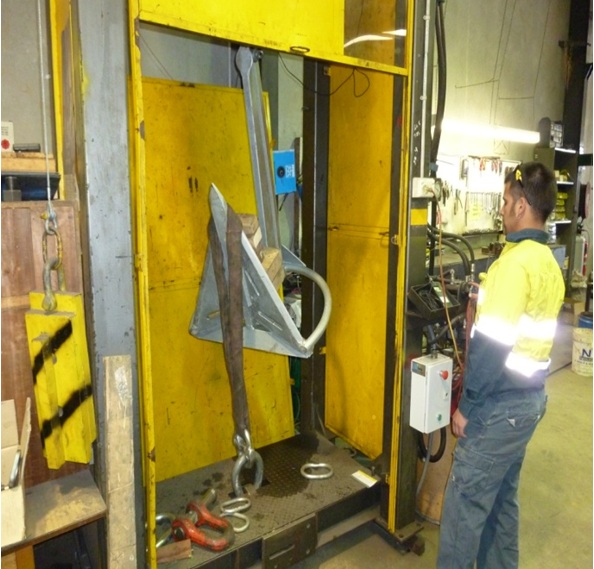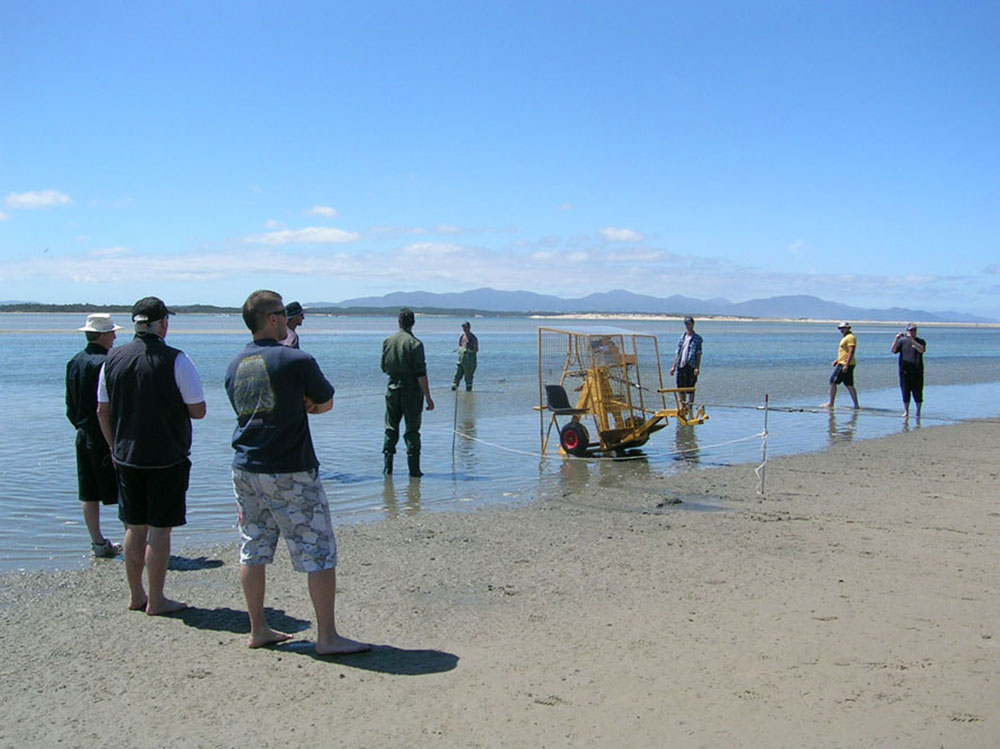Explained below, the benefits of proof testing and why it is done.

Like Lloyd’s, or ABS, Robertson’s are NATA approved.
We start off with a recognized testing Authority Robertson’s a NATA testing station that have thirteen facilities Australia wide


For Super High Holding Power certification the (NMSC) National Marine Safety Committee of Australia authorized Roberson’s to perform the field and proof testing on our complete range of anchors. This testing is in line with Lloyds and the USL Code for S/H/H/Power and the latest regulations for commercial vessels design and construction of anchors.
Robertson’s is a third party to an independent test, notice the three guys to the right on the left hand photo is a fourth witness and report party that consist of three marine Survey officers from Transport Safety Victoria, they are there to make sure the testing is correctly performed in line with Lloyds and the USL Code.


The Proof Test
Notice how the anchors are proof tested, and what this test achieves in strength of construction of design. The shank is coupled to a hydraulic ram and the fluke plate is anchored to a concrete block. This load is applied at two thirds of the distant from where the shank is welded to the fluke plate to give maximum leverage on construction and welds.
The NMSC ,Lloyds, RHINA , DNV all apply the same tests in the same manner for proof of Super High Holding Power construction. Field testing is another issue that is clearly explained on our TATS (Tidal Anchor Test Skid) page.
This commercial Super Sarca anchor weighs 185 K.G. and has to with stand a load of ten ton, you may still not understand this in relation to a side pull. These loads that are applied in the vertical are deemed, proved by the USL code and Lloyds to be way above loads recorded in the straight pulls from a vessel, these loads take into account side pull loads, this method still doesn’t give us a simple way of understanding how, but it works, it is a tried and proven bench mark of an anchors strength.
If the classification societies are happy, it is difficult to argue with. A side load pull test might be easier to understand, but Lloyd’s does not ask and testing anchors are expensive, guess who pays, so we try to limit testing to the realistic.
Proof testing eliminates the use of poor quality steel and gives you construction design improvements resulting in a quality product. When you purchase an anchor most would buy on marketing and feedback, that’s fine but don’t just rely on hearsay.
You have the right to ask for proof of what they are pedaling. Make no mistake your life could one day depend on a well-built anchor or a Gerry built one.


Our latest in design, Super Duty Excel weighing in at 105 KG, we believe this Super duty range of Excel anchors will be the strongest anchors ever, in this photo we had Robertson load the Super Duty Excel to the required proof load five ton, no deformation was present, we then had them take it to ten ton, then fifteen ton still no deformation, deformation occurred at twenty ton with slight bending of the shank.
Simply loading the Excel to four times the load required further reduces any chance of bending due to a sideways pull.
As a matter of interest, the excel anchor from 16 K.G. and up all have Bis plate 80 shanks, Super Sarca all sizes have grade 350 mild steel shanks.
Mild steel you say? Yes because the Super Sarca design allows for thicker heavier shanks that more than accommodate the same strength as a thinner Bis Plate shank.
Proof testing has many advantages, if you are designing anchors, proof testing is the only way you are going to find their weaknesses, we test not just for accreditation but to destruction, this is an enormous help when we develop larger anchors to hold these commercial vessels. See how long you would last in the industry if these fellows bent shanks.


We have been in anchor design and manufacturing for many years now and have carried out hundreds of hours of research and Yes we make anchors out of stainless steel, the fluke plates are of 316 and the shank of a grade 50 percent stronger.


Stainless has absolutely no flexing properties and will yield relatively easy on impact. If a customer wants one, we will always try and talk them into a steel version but if they insist we explain the downside to stainless. Another point, bend the shank on a stainless anchor and you can bin it, bend the shank on a steel anchor you can straighten it.
When purchasing a Stainless steel anchor of any design whether it be a solid shank or hollow it will still yield relatively easy on impact as it will not flex.more expensive but an inferior product to that of Bis plate, furthermore stainless steel anchors are not covered under S/H/H/Power certification of steel anchors, we know this from proof testing, so certification for stainless means testing all over again with stainless for anchors over 50 K.G.
All of our field testing was carried out against a Manson Supreme, why?, because it has Lloyd’s approval that was stipulated to Robertson’s by the N.M.S.C. as a bench mark for testing Super High Holding Power Certification. Who is the N.M.S.C. you can Google them, shortly their role will be taken over by AMSA. If you wonder who AMSA are, again Google, but they are the guys who will rescue you if you come a cropper in the Great Southern Ocean. They also decide if large commercial vessels are correctly certified to enter Australian waters. They have the Authority to query any classification Society Certificate, so they know their stuff.
We at Anchor Right Australia are more than happy to share our info on anchor design construction testing and so on.
Finally; why all anchor manufacturers can’t be honest, transparent with their testing methods, steel types beats me, why should any of this be confidential, we at Anchor Right are proud to show of the extent we go to with our anchor designs.
Check out our unique T.A.T.S. rig, Tidal anchor test skid for all of our field testing, now recognized as a new standard for more accurately measuring the holding power of an anchor.

If it hasn’t been field tested with T.A.T.S. THEN AS FAR AS WE ARE CONCERNED IT HASN’T BEEN TESTED.




